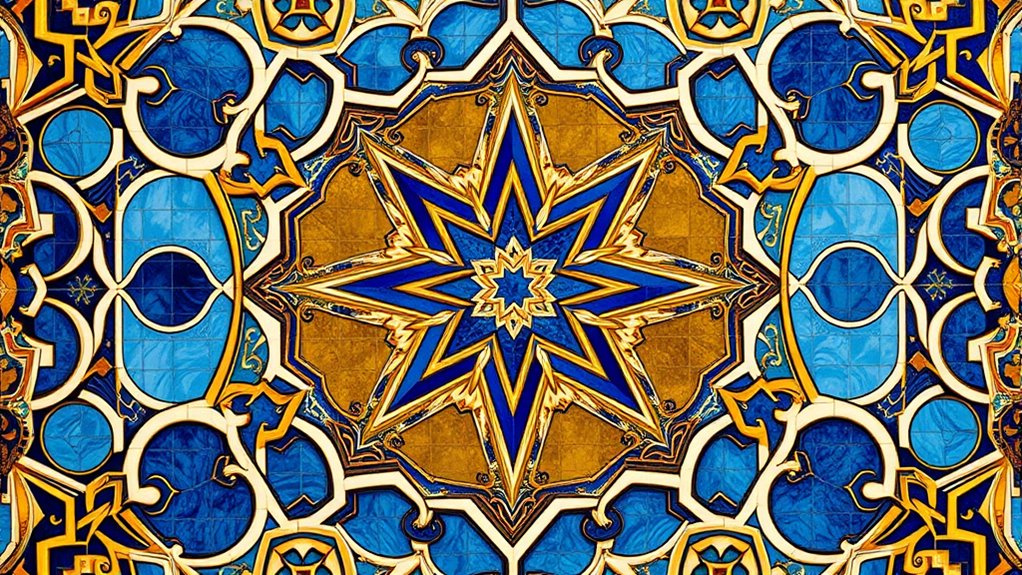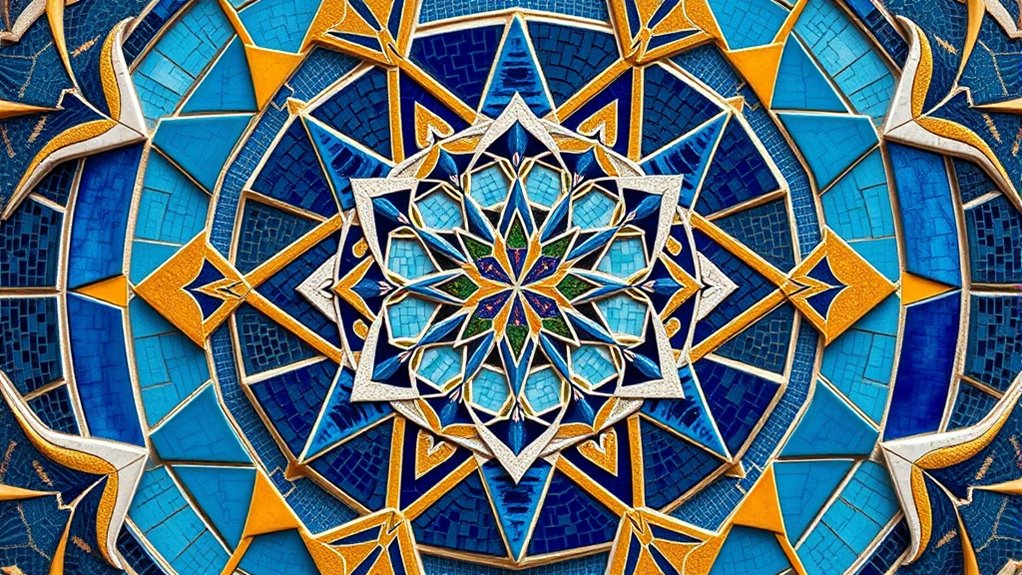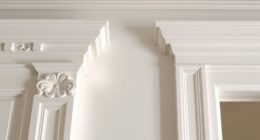Sacred geometry in tile and wall designs combines universal patterns like circles, triangles, and mandalas to symbolize harmony, unity, and spiritual connection. These intricate patterns, inspired by ancient cultures, serve as visual metaphors for cosmic order and spiritual growth. By using symmetry, repetition, and harmonious colors, you can create spaces that evoke calmness and deep significance. To discover more about how these designs can transform your environment, explore the details beyond this overview.
Key Takeaways
- Sacred geometry patterns like mandalas and star polygons are used in tile designs to symbolize unity, harmony, and cosmic order.
- Repeating geometric motifs create visual rhythm and infinity effects, promoting contemplation and spiritual connection in wall art.
- Techniques involve selecting symbols aligned with intended meanings, using color harmony, symmetry, and subtle variations for depth.
- Incorporating sacred geometry in tiles enhances aesthetic appeal, fosters calming ambiance, and deepens cultural or spiritual significance.
- Modern architecture often features geometric tile patterns inspired by sacred proportions, emphasizing harmony and universal patterns in interior design.
The Origins and Significance of Sacred Geometry

Sacred geometry has fascinated humans for centuries because it reveals fundamental patterns that underpin the universe. These geometric principles are rooted in mathematical concepts that describe natural forms and cosmic order. Ancient cultures recognized these patterns as more than just shapes—they held deep cultural symbolism and spiritual meaning. For example, the circle, square, and triangle often represent unity, stability, and harmony. These symbols were integrated into architecture, art, and religious rituals, emphasizing their cultural significance. Sacred geometry served as a bridge between the physical and spiritual worlds, guiding the design of sacred spaces and objects. Understanding mathematical concepts underlying these patterns allowed civilizations to connect with the divine and express their beliefs through intricate tile and wall designs that continue to inspire today.
Popular Sacred Geometric Patterns in Tile Art

Among the most mesmerizing elements of tile art are the intricate sacred geometric patterns that adorn walls and floors worldwide. You’ll notice that many designs feature mandala symbolism, representing unity and spiritual wholeness. Geometric tiling patterns like star polygons, tessellations, and arabesques are common, each conveying harmony and balance. These patterns often serve as visual metaphors for cosmic order and spiritual growth. The repeating nature of these designs creates a sense of infinity, drawing your eye inward and encouraging contemplation. Whether in Islamic mosaics or Gothic embellishments, these sacred patterns emphasize the profound connection between geometry, spirituality, and art. Additionally, the use of visual symbolism in these designs enhances their spiritual significance and aesthetic appeal.
Techniques for Incorporating Sacred Geometry Into Design

To effectively incorporate sacred geometry into your design, start by selecting patterns that resonate with your intended symbolism and aesthetic. Focus on achieving color harmony by choosing hues that complement each other and enhance the geometric motifs. Use pattern repetition strategically to create visual rhythm and unity throughout the space. Repeating shapes or symbols can emphasize the design’s sacred meaning while maintaining balance. Incorporate symmetry to reinforce harmony and guide the viewer’s eye naturally across the surface. Experiment with scaling different patterns to add depth and interest. Keep in mind that subtle variations in color and repetition can dramatically influence the overall atmosphere. Additionally, understanding the best anime movies can inspire creative visual storytelling within your design elements. By thoughtfully combining these techniques, you’ll craft a cohesive, meaningful design that highlights sacred geometry’s timeless appeal.
Benefits of Using Sacred Geometry in Interior Spaces

Incorporating sacred geometry into interior spaces offers numerous aesthetic and psychological benefits that can enhance your environment. The symbolic meanings behind geometric patterns can evoke feelings of harmony, balance, and spiritual connection, enriching your space’s atmosphere. These designs often carry cultural influences that deepen their significance, creating a sense of rootedness or universality. Using sacred geometry can promote a calming ambiance, reduce stress, and foster mindfulness. Additionally, these patterns can serve as focal points, adding visual interest and a sense of sophistication. When thoughtfully integrated, sacred geometry not only beautifies your environment but also encourages positive energy flow. Recognizing the emotional support that these designs can provide, they help create spaces that feel intentional, inspiring, and spiritually resonant.
Inspiring Examples of Sacred Geometry in Modern Architecture

Modern architecture increasingly draws inspiration from sacred geometry, integrating its principles into striking designs that blend aesthetics with spiritual symbolism. These structures showcase the Mathematical Foundations behind sacred patterns, creating harmony and balance that resonate deeply with viewers. You’ll notice how cultural significance influences these designs, reflecting diverse traditions and beliefs. Additionally, the use of geometric shapes in these designs often enhances both structural integrity and visual appeal. Examples include:
- The intricate geometric patterns in the Sydney Opera House’s shells
- The use of Fibonacci spirals in Gaudí’s Sagrada Família
- Circular mandalas incorporated into the design of modern temples
- The Pentagon’s structural symmetry inspired by sacred proportions
These applications demonstrate how sacred geometry elevates architecture beyond function, connecting viewers to universal patterns rooted in cultural stories and spiritual symbolism.
Frequently Asked Questions
How Do Different Cultures Interpret Sacred Geometry in Tile Designs?
You see that different cultures interpret sacred geometry in tile designs through their unique cultural symbolism and artistic expression. For example, Islamic art uses intricate geometric patterns to symbolize the infinite nature of Allah, while in Hindu design, sacred symbols represent spiritual concepts. You’ll notice these designs serve as visual storytelling, reflecting each culture’s beliefs and values, and transforming architectural spaces into meaningful, sacred environments.
What Materials Best Showcase Sacred Geometric Patterns in Wall Art?
You should choose materials like glazed ceramic or porcelain for wall art, as they offer excellent durability to withstand wear and environmental factors. These materials also showcase vibrant color palettes, helping sacred geometric patterns stand out vividly. Additionally, natural stone like marble or limestone can create a timeless look, emphasizing intricate designs with subtle, elegant hues. Prioritize durability and color richness to truly highlight sacred geometric patterns in your wall art.
Can Sacred Geometry Influence the Emotional Atmosphere of a Space?
Did you know that spaces with sacred geometry often evoke a 30% greater sense of calm? Sacred geometry influences the emotional atmosphere by creating spatial harmony, which can foster feelings of peace and balance. When you incorporate these patterns, you enhance emotional resonance, making your environment feel more intentional and soothing. So, yes, sacred geometry can powerfully shape how you experience and connect with a space.
Are There Specific Tools or Software for Designing Sacred Geometric Tiles?
Yes, you can use digital design tools like Adobe Illustrator or AutoCAD for creating sacred geometric tiles. These software options let you visualize patterns precisely, ensuring your designs align with sacred geometry principles. You can experiment with pattern visualization easily, adjusting proportions and symmetry before production. This approach helps you craft intricate, meaningful tile designs that reflect spiritual concepts while maintaining visual harmony in your space.
How Does Sacred Geometry Impact the Longevity and Maintenance of Tile Surfaces?
Sacred geometry can dramatically boost the durability of your tiles, making them last longer than you’d expect. Its precise patterns help distribute stress evenly, reducing cracks and damage over time. To keep your sacred geometric tiles looking perfect, implement proper cleaning techniques, avoiding harsh chemicals that can erode their beauty. With the right care, your tiles will maintain their intricate designs and withstand the test of time, truly becoming timeless masterpieces.
Conclusion
By incorporating sacred geometry into your tile and wall designs, you turn your space into a harmonious sanctuary, much like a symphony where every note matters. These patterns not only add visual beauty but also evoke deeper spiritual and cultural meanings. When you embrace sacred geometry, your surroundings become a canvas of balance and connection, transforming ordinary spaces into extraordinary ones—like a garden blooming with purpose and grace.










